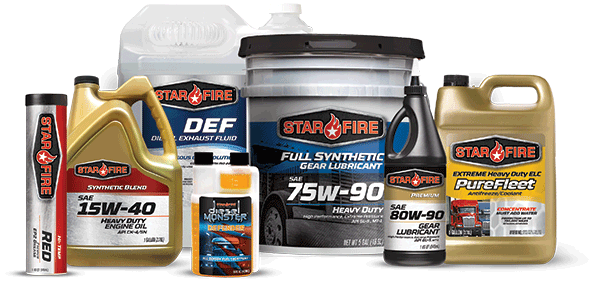Focused on Performance and Efficiency
Many of the pain points caused by the COVID-19 pandemic have now eased for the heavy-duty engine oil segment, with the market now able to turn its focus back to what counts: producing high-performance products suited to the most demanding conditions.
The onset of the pandemic sent ripples throughout the global supply chain, causing bottlenecks and shortages that proved a particularly difficult period for the commercial vehicles market, with some struggling to source specific lubricants and engine oils.
Today, the outlook is far more positive, and the push to improve fuel economy and lower harmful emissions continues to gather speed.
“I think we can see that there’s now light at the end of the tunnel and we’re definitely moving in the right direction,” said Greg Matheson, commercial lubricants product manager at Lubrizol. “In the last three to four months, the supply chain has been improving, and product is back on shelves. I’ve also seen that truck sales in North America are growing year-on-year, which means fleets are not only buying new equipment, but that they’re also going to need the latest and greatest lubricants—and that’s a very positive sign for the market.”
HDEOs are formulated to protect diesel engines in a broad range of on- and off-road applications. That means that they must endure the toughest and most demanding conditions without limiting performance and durability.
With vehicles being placed under greater strain than ever before and engines running hotter and longer than they have historically, improving efficiency and minimizing downtime is a must for fleet operators. Selecting the right lubricants that boast excellent oxidation control and wear protection is therefore paramount.
Indeed, customers are demanding extended oil-drain intervals as well as higher levels of performance to better protect their engines, Matheson said.
“Maybe 10 years ago in the commercial vehicle space, you’d have an ODI of between 25,000-30,000 miles,” he explained. “That’s since been extended to around 45,000-55,000 miles, but there are some OEMs now telling their customers they can extend that to 75,000 miles between oil changes. Those ODIs have doubled in some cases from where they were 15 years ago. And that’s where the oxidation control becomes important.”
Wear protection is also key, Matheson said. End users buying trucks want longevity and reliability from their vehicles. They want the oils they use to perform to the requirements specified by the OEMs, so that the warranties are protected as well as their engines.
Fueled by environmental pressures and stricter legislation, the HDEO segment has seen a sustained push toward API FA-4 and lower viscosity oils—notably a shift away from 15W-40 to 10W-30 and, in some cases, 5W-30.
“OEMs have had to change their hardware over the past decade, and a lot of aftertreatment device changes are helping to clean up the emissions. One of the ways we can help from a lubricant standpoint is through low viscosities,” Matheson said.
“There are few a drivers for this,” he continued. “In Europe and North America, there’s a lot of legislation around emissions control and carbon dioxide and nitrogen oxide (NOx) reduction, which started with very stringent laws back in 2016. Another big iteration is coming in 2027, with the U.S. Environmental Protection Agency and the California Air Resources Board setting really strict restrictions with its greenhouse gas regulations. The introduction of new oil category PC-12 is being driven by those regulatory rules.”
Although around 70% of the market is still using 15W-40 engine oils, most OEMs in North America have been factory filling with 10W-30 API CJ-4 or CK-4 engine oils for well over a decade. However, few utilize API FA-4 low-viscosity products introduced at the end of 2016. End users are slowly starting to realize the associated benefits of switching, such as better fuel economy, and SAE 10W-30 CJ-4/CK-4 has grown rapidly over the past 10 years.
Yet despite the introduction of even lower viscosity FA-4 oils for even better fuel economy, there still appears to be some resistance to change, noted Steve Haffner, president of SGH Consulting.
“Everybody wants better fuel economy and lower emissions; the problem is a lot of fleet managers feel a lower viscosity may not protect their engines as well from a wear point of view,” Haffner said. “That has meant the uptake for API FA-4 lower-viscosity products has not been great and not every OEM has even adopted them. On the off-road commercial side, for example, with construction and mining equipment, cement mixers, garbage trucks and so on, these still predominantly use 15W-40.”
Most fleets have both old and new engines, and FA-4 has no backwards compatibility via API and only limited back serviceability from one OEM. As fleets prefer to carry one oil that is capable of managing the maintenance for all their equipment, this also hinders the acceptance of the new oils, Haffner said.
Matheson pointed to independent studies on low-viscosity engine oils from the North American Council for Freight Efficiency (NACFE) that suggest changing from 15W-40 CK-4 oil to a 10W-30 or 5W-30 can result in a 0.5%-1.5% fuel efficiency boost. If a fleet were to go from a CK-4 to an FA-4 10W-30 or 5W-30, there would be another 0.4%-0.7% improvement, he said.
“The data is really strong and shows any fleet running 15W-40 that makes that jump to an FA-4 could save close to 2.0%-2.2% and get far better fuel efficiencies,” Matheson said. “That translates to a lot of money saved when you consider the miles they drive each year.”
Before too long, fleet managers will have to embrace the newer PC-12 oil category as well. Set to be introduced from January 2027, it will be almost exactly a decade since its last update.
“The EPA and legislation are driving higher requirements to the diesel engine makers on emissions,” Haffner said.
“Today’s’ products are very good,” he continued. “PC-11 was a big upgrade over PC-10 in terms of oxidative stability and the introduction of FA-4. Now, industry is working on PC-12 and the question is, what is it going to look like and how much is it going to cost? Right now, PC-12 is shaping up to be pretty expensive. A key issue is many of the existing engine tests for PC-11 are not going to be available and alternatives must be developed. If you don’t have replacement engine tests, then even the existing categories can’t be maintained, so developing replacement tests are a driver to both new and existing heavy-duty engine oils.”
There are still several key elements of PC-12 that have to be decided on, but there has been a lot of good progress made recently.
OEMs have identified several key criteria to help with the transition in the coming years. These include increased oxidative stability, greater wear protection, and a lower High-Temperature, High-Shear (HTHS) of 2.6, which equates to 0W-20 oils—or passenger car viscosity grades—being used in the commercial vehicle market. The OEMs believe this will not only benefit the engines but will offer greater compatibility with aftertreatment devices, Matheson said.
“There’s been a lot of discussion over the past year or so about testing and whether we have the right engine tests to demonstrate there is added wear protection with these oils, and that they offer better oxidation control. As an industry, we need to come up with a clear value proposition to the end user market about why this is needed and where they’re going to see the benefits with PC-12,” he said.
Several additional tests have already been proposed, including the Detroit Diesel DD13 Engine Scuffing Test and another from Ford—a 6.7-liter valve train wear test designed to look at how these oils perform in severe operating conditions. There are also two replacement test options for a legacy test—the Volvo Mack T-11 soot viscosity test—that can no longer be supported from a hardware standpoint.
“A lot of focus right now is on the next generation of engines coming out around that 2027 timeframe,” Matheson said. “As an industry, we’re all working together with the OEMs to help deliver them engine oils that can help them meet all those regulations and, most importantly, translate into the end user benefit of efficiency while not compromising the durability of the engine.”
In this Spotlight, STARFIRE showcases its range of heavy-duty engine oils.

Achieve Peak Performance with STARFIRE HDEOs

Proven, dependable, and reliable—all qualities that have helped position STARFIRE as the brand of choice for heavy-duty engine oils (HDEOs). With an expansive range, it prides itself on supplying premium products without the premium prices.
STARFIRE, the leading lubricants brand of Ohio-based wholesale distributor Coolants Plus, has been serving customers with heavy-duty products ever since its launch in 1999. The business has enjoyed particular growth and success over the past decade, with its sales extending beyond North America to international markets.
“The STARFIRE brand and our different grades of HDEOs satisfy the needs of everyone from owner operators to large service center fleets, and is backed up by our award-winning customer service,” says Tim Wullenweber, VP of marketing and technical services at Coolants Plus, Inc. “Our HDEOs are premium high-performance fluids suited for any diesel engine that requires an API CK-4 specification—from semi trucks and pickups to dump trucks, garbage trucks, and off-highway construction and agriculture equipment.”
STARFIRE oils meet all OEM specifications and are licensed with the American Petroleum Institute (API). “Large fleet companies don’t have to worry about approvals or their warranties, as we have OEM approvals from Cummins, Detroit Diesel, Volvo, Mack, Renault and
Mercedes-Benz,” he says.
“We have a great range of heavy-duty fluids. The 15W-40 is still by far the largest mover in the segment, but we are also able to offer Synthetic Blend 10W-30 and Full Synthetic 5W-40 and 15W-40—all much more affordable than the larger suppliers but with the same high levels of quality.”
STARFIRE has forged a reputation for its unparalleled customer service and support, and short lead times. Its extensive line-up of premium products provides a one-stop shop for all your heavy-duty service items—meaning fleet companies don’t have to source their motor oil from one supplier, gear oils from another, and antifreeze or diesel exhaust fluid from someone else.
A manufacturer and wholesale distributor, STARFIRE boasts its own fleet of bulk transport trucks and tankers to meet the very specific needs of markets, including heavy-duty, automotive, industrial, agriculture and construction.
The business blends its own motor oils, gear oils, industrial oils, transmission fluids and custom formulations at its PennStar facility in Northampton, Pennsylvania. The modern 300,000-square foot site has a production capacity of over 3.5 million gallons each month.
Offering affordable, high-quality products and award-winning service, STARFIRE makes light work of your heavy-duty needs.
